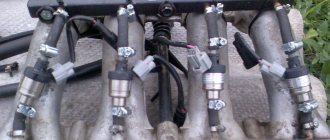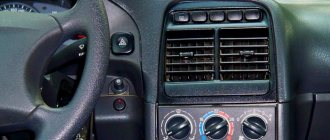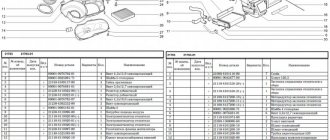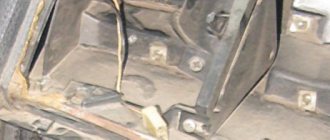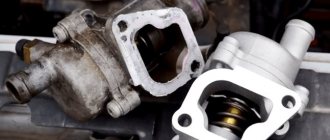Probably one of the most unpleasant breakdowns that can happen to a car in winter is heater failure. The heating system takes on special importance in cold weather - no one dares to argue with this statement.
For what reason the stove in a VAZ-2115 car does not heat, and how exactly to eliminate such a problem, we will tell you in the article below.
The design and principle of operation of the VAZ 2114/15 stove
The heating system of the VAZ 2114/15 is designed to heat the air entering the passenger compartment. Its design is the same in cars with injection and carburetor engines. The coolant heated by the engine flows from the cooling system into the heater radiator, which is blown by a fan. The flow of warm air created in this way enters the cabin through the air duct system. The intensity and direction of air flow is regulated using deflectors and dampers. The interior heating system of the VAZ 2114/15 can operate in several modes.
Prevention methods
To avoid a reoccurrence you will need:
- The first preventative measure is to disassemble the system in advance and clean every part.
- The presence of a clean cabin filter under the hood. As you understand, a dirty and clogged filter prevents the passage of hot air, and for the same reason the radiator becomes covered with a large layer of dirt.
- Fresh antifreeze. It needs to be changed regularly and maintained at the proper level. Then the air supply to the radiator through the thermostat will be uninterrupted.
- Hermetically sealed faucet and radiator. This can be verified when the engine is well warmed up.
A functioning heating system will be confirmed by the silent, well-functioning operation of the fan and a continuous flow of warm air even when the car is static.
Tuning VAZ 2115 → How to make
so that warm air blows
Problem, overboard.34 (Surgut. Khanty-Mansi Autonomous Okrug), we are drifting through the expanses of the Siberian region, in the cabin, at all 90 degrees, a little warm air is blowing from the stove. WHAT SHOULD I DO TO TAKE HIM MOM??
There are proposals from strangers to my beloved co-worker. mechanics: 1) put a piece of cardboard behind the grill (I did it last year, it seemed a little warmer; 4.5) put the heater filter in the trunk (somewhere under the hood on the left near the heater); 3) change the radiator to a copper one (the downside is that you are unlikely to find it on sale; I think it’s a rare example)
PS. By the way, no matter how much I travel in the door, it blows, God forbid, and it’s very hot
- Rimma_Fahreeva
- 02 July 2012, 12:36
- Gesser_Shorin
- 02 July 2012, 12:41
- v
- Anonym_Nafikov
- 03 July 2012, 09:32
- v
Stove design
The VAZ 2114/15 stove consists of the following elements:
- Fan.
- Windshield defroster.
- A distribution flap that directs air flow to the central and side deflectors, to the lower and upper parts of the cabin.
- Control valve.
- Stove radiator.
- Duct that directs air flow to the legs.
- Internal air duct.
Heater fuse and reasons for its failure
Often the cause of malfunction of most components and systems of a car is a blown fuse. The stove is no exception. Failure of a 30A heating system fuse causes the fan motor to stop and air to stop flowing into the cabin. In this case, find an element marked F7 in the fuse block and replace it. The new fuse should also be rated 30A. If the fan does not work after this, the problem should be looked for elsewhere.
It is often difficult to determine that it is the fuse that has blown. It can fail due to a short circuit in the electrical wiring, a malfunction of the electric motor, severe clogging of the cabin filter and in a number of other situations. The difficulty lies in the fact that fuse F7 is simultaneously included in the rear window heating electrical circuit and is responsible for the cigarette lighter, glove compartment lighting and headlight washer motor. If it fails, all these components will not work.
Pump malfunction
Very often, drivers explain poor performance of the heater at idle by a breakdown of the water pump. This is due to the fact that at XX the pump impeller rotates at low speed, which cannot ensure high-quality circulation of antifreeze (antifreeze). As a result, heat exchange deteriorates and insufficiently hot air enters the cabin. When you press the gas pedal, the speed of rotation of the impeller increases, which immediately entails an increase in the air temperature in the cabin.
For more accurate diagnostics of the pump, it must be removed from the engine. Very often, a pump malfunction is accompanied by overheating of the motor. A visual inspection of the item will indicate its condition. If the impeller is jammed, spins on the shaft, or its blades are scattered, the pump must be replaced.
Why the stove does not work or does not heat the air
If the stove fails, it either does not work at all, or it works but does not heat the air. In the first case, first check the fan wiring, starting with fuse F7. If the fuse is blown, replace it. Then they check the relay, which may not turn on the first time or only when the engine is warm. In this case, the relay is replaced with a new one.
Then the serviceability of the electric motor is assessed. To do this, power is directly supplied to its contacts from the battery. If the electric motor starts to operate at maximum speed, then it is in good condition. Otherwise, it will need to be repaired or replaced.
Failure of the cylinder head gasket
You need to understand that damage to the cylinder head gasket leads to mixing of oil with antifreeze or exhaust gases entering the cooling system. Usually the problem is quickly diagnosed by obvious signs. But some drivers note that minimal burnout of the gasket may be accompanied by the appearance of excess air in the cooling system.
The only solution may be to replace the cylinder head gasket, but we advise you to take your time and check all other factors first. This is an expensive procedure and a rare problem, so save it for last.
Heater dampers don't work
The distribution of air flows throughout the cabin is carried out by dampers, which, in turn, are controlled using cables. When these cables fail, problems arise with directing the air flow to the windshield or to the foot area. In addition, the damper that blocks the flow of air from the street begins to work incorrectly. In this case, adjustment of the damper drives is required.
Such situations can arise even on a new car. Slightly warm air begins to flow from the lower, upper and side deflectors, and hot air begins to flow from the center console. This is due to the poor build quality. There are gaps between the joints of the air ducts and the dampers, which leads to warm air entering only from the center console and heating the panel from the inside.
The drive cable is always taut. Therefore, over time it bends, breaks off or stretches. In this case, it is necessary to adjust the damper drive, which is performed in the following order:
- In the stove, we look for a bracket with which the cable sheath is held on the heater body.
- A galvanized metal lever located on the left side is pulled back. This position corresponds to the maximum opening of the damper.
- The length of the cable is tightened and adjusted. The long lever on the lever block in the extreme right position should open the damper completely.
- After adjustment, the cable is securely fixed.
Thermostat malfunction
Sometimes the thermostat can become stuck open. As a result, antifreeze will constantly circulate in a large circle. Accordingly, it will not be able to warm up normally. In some cases, the thermostat simply does not completely close the large circle. This has virtually no effect on engine operation, so diagnosing the problem is difficult.
The solution is to check the thermostat and replace it if a malfunction is detected.
Why is antifreeze leaking from the stove?
A coolant leak in the heating system can occur from:
- stove radiator;
- stove tap;
- stove pipes.
If a coolant leak occurs from the radiator, it is usually replaced with a new one. Repairs to restore tightness are usually complex and labor-intensive. In addition, if the radiator has been in use for a long time, its tubes become clogged with deposits and dirt, and, as a result, heat transfer decreases.
The valve opens and closes the coolant supply to the radiator, thereby regulating the heat in the cabin. Over time, it may begin to leak, as evidenced by the characteristic smell of antifreeze in the cabin, a puddle on the floor on the passenger side and a decrease in the coolant level in the expansion tank. The faucet cannot be repaired and in such cases is replaced entirely.
If the heater radiator begins to leak, it is usually replaced with a new one. The reason for coolant leakage from the pipes is usually their wear - the rubber ages and cracks over time. When diagnosing a problem, you need to wipe the suspected leak areas with a rag and observe the outlet and inlet pipes on a warm engine. Worn hoses are always replaced with new ones.
The stove makes a hum, whistle, murmur
The cause of uncharacteristic sounds (whistle, hum, murmur, etc.) from the heater is usually a faulty electric motor. Lack of lubrication, contamination, wear of bearings and bushings - all this leads to the fact that the motor begins to whistle. It is removed, disassembled and cleaned, and the rubbing elements are lubricated. If the bearings are heavily worn, the motor will not make a whistle, but a hum. In such a situation, lubricant may not help, and the electric motor will need to be replaced.
Steam is coming from the stove
Sometimes steam starts coming out of the stove. The reason for this is a leak in the heater core. The leaking coolant hits the hot radiator housing and begins to quickly evaporate, and the smell of antifreeze appears in the cabin. To fix the problem, you will need to disassemble the stove and replace the heat exchanger.
Sometimes white steam comes from under the hood and enters the cabin. This happens when antifreeze gets on the hot manifold or exhaust system pants. In this case, you will need to find the location of the leak and fix it. The most common cause is damaged pipes.
How to disassemble the VAZ 2114/15 stove
The stove on the VAZ 2114/15 is located in an extremely inconvenient place. To dismantle and disassemble it you will need:
- Phillips and slotted screwdrivers with short and long handles or a screwdriver;
- set of wrenches;
- container and rubber hose for draining coolant;
- rags, a piece of oilcloth.
Dismantling the stove radiator
Dismantling the heater radiator is carried out in the following order:
- When the engine is cold, the coolant is drained.
- The screw located behind the plastic plug is unscrewed.
- The glove compartment is dismantled. To do this, first remove the lower part, and then the cover with the lighting lamp. Then the six screws securing the upper part are unscrewed. With a slight push and turn, the top of the glove compartment lowers and pulls out.
- The plug is removed from the cigarette lighter socket and the power connectors of the radio are disconnected. The radio is removed from its seat.
- The connectors on the console that interfere with its complete dismantling are disconnected. The connectors are marked for ease of subsequent assembly.
- The ashtray illumination block is disconnected.
- Two self-tapping screws are removed from the diagnostic connector. The center console is removed.
Replacing and connecting the stove
Installing a new heater radiator is done in the reverse order. When installing rubber hoses, it is recommended to treat them with sealant. When connecting electrical connectors, use the markings applied during disassembly.
After assembly, coolant is poured into the system. To prevent an air lock from forming, remove the hose from the throttle assembly after loosening the clamp. Antifreeze should be poured into the expansion tank slowly, observing the disconnected hose. As soon as coolant flows out of it, the hose should be put back on the fitting and tighten the clamp. If everything is done correctly, the operation of the stove will not cause any complaints.
When installing a new heater radiator, it is recommended to pre-treat the pipes with sealant
Video: dismantling the VAZ 2114 stove
Fan motor repair
If the electric motor malfunctions, it should first be removed and then the feasibility of repair should be determined. It is necessary to evaluate the condition of the brushes, armatures, windings, and check the integrity of the wire insulation. The contact area of the brushes on the armature can be cleaned with zero grade sandpaper. You should also pay attention to the bushings and bearings - clean the rubbing parts from dirt and apply lubricant (for example, Litol). All elements with signs of wear must be replaced.
Heater radiator repair
Usually, if mechanical damage is detected, the stove radiator is replaced with a new one. However, some car owners try to repair cracks and holes using soldering. A copper radiator is quite easy to solder, and it is much easier to restore than an aluminum one. To repair an aluminum heat exchanger, you will need special flux and tinning solder, as well as a powerful soldering iron. The damaged area is first cleaned of dirt and degreased. Then flux and solder are applied to it with a soldering iron. After soldering, it is recommended to check the radiator under pressure to make sure there are no leaks.
Brand name – LRh – Luzar Radiator heater
Heating radiators (also known as heater radiators, also known as heater radiators) are heat exchangers that use the heat generated by the engine to heat the vehicle interior. They allow you to maintain a comfortable temperature and prevent the car windows from fogging up.
For reference: different names of this node have equal rights of use. For example, “heating radiator” and “stove” come from the function of this heat exchanger, “heater radiator” and “stove radiator” - from the installation .
LUZAR manufactures hundreds of heater radiators for a wide range of cars presented on the Russian market. They can be purchased in partner stores throughout Russia or online.
Many models of heater radiators are supplied to car factories in Russia and Ukraine - both for passenger cars and for trucks and buses.
The production range of manufactured stoves is constantly increasing; New types are being developed for the most popular cars in Russia.
Powerful R&D allows us to conduct research in the field of improving heat exchangers and create new designs that provide increased performance properties of heater radiators. Main areas of research:
- use of different types of tubes
- changing the location of the tubes
- change in the “fillability” of the core
- use of turbulators-swirlers
- use of various aluminum alloys
- testing of solders with different characteristics
- improving the corrosion properties of metal
- ... and many other R&D areas.
Cleaning and flushing the radiator of the VAZ 2114/15 stove
You can increase the efficiency of the stove by cleaning and flushing the radiator. The procedure can be performed without dismantling the radiator or with dismantling it. In the first case, you will need to remove the outlet and inlet pipes from the heater and pour a cleaning solution into it. Citric acid, plumbing cleaners (for example, “Mole”), etc. are used as such a solution. Then the radiator is washed with running water and coolant is added. You can clean the radiator better by removing it from the car. This will allow you to wash it not only from the inside, but also from the outside, removing dirt between the honeycombs. Washing is usually carried out with running water.
If after performing these procedures the stove does not work better, the radiator must be replaced.

